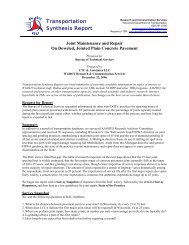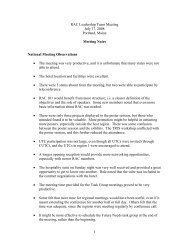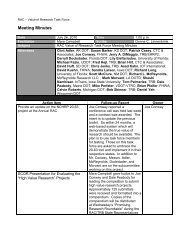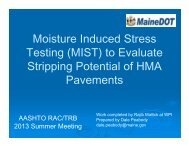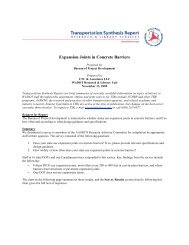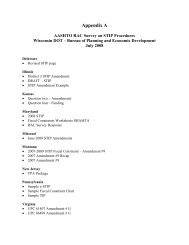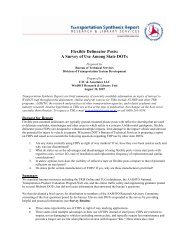Highway Maintenance Response Time Standards
Highway Maintenance Response Time Standards
Highway Maintenance Response Time Standards
You also want an ePaper? Increase the reach of your titles
YUMPU automatically turns print PDFs into web optimized ePapers that Google loves.
Established <strong>Response</strong> Processes - The Ohio Department of TransportationA highway maintenance program involves the systematic process of planning, implementing, measuring, and makingimprovements with highway maintenance. County Managers are responsible for the inspection of all conditionswithin the entire highway system in their county on a bi-weekly basis. Inspections should be documented and filed asa reference for planning and prioritizing maintenance activities , and to provide as evidence to the Court of Claimswhen requested as part of an investigative report. Decisions are based on the cost effective use of limited resourcesto improve efficiency and protect the investment in the State’s existing transportation infrastructure.Responding to roadway deficiencies in a timely manner is proper protocol at ODOT. <strong>Time</strong>ly can be defined asrelative to the severity or priority and nature of the problem. A stop-sign for instance would require immediateattention and response. Reactionary maintenance involves activities undertaken to correct defects and extend the lifeof the pavement until such a time that a proper rehabilitation or reconstruction project may be undertaken. Reactivemaintenance is frequently performed on a failing pavement. It is a stopgap measure that keeps the road at anacceptable serviceability, and is seldom cost-effective but necessary to keep the highway system safe for thetraveling public.Culvert failure results in costly emergency replacements, flooding problems, and hazardous conditions for motorists.Remedial repairs are more cost effective than full replacement when deficient conditions are detected early. Culvertconditions on a route can be used as a planning tool for the County Manager to ensure deficient structures arereplaced prior to road resurfacing, to forecast project costs by knowing the condition of large culverts that requirework in conjunction with other projects, and to supply feedback for design and specification.The inspection and sharing of information related to highway conditions are everyone’s responsibility. All ODOTmaintenance personnel performing maintenance task or ODOT inspectors administering construction projects areobligated to share observed highway conditions with the appropriate managing authority.The Court of Claims Section is responsible for managing all administrative and judicial claims for money damageswhich are filed against ODOT in the Court of Claims of Ohio. Administrative claims are those claims seeking $2,500or less and typically involve damages due to potholes, paint over-spray or debris in the roadway. Judicial claims areclaims more than $2,500 and typically involve wrongful death, personal injury or contract claims. While the court ofclaims coordinator and staff handle all administrative claims in-house, the Ohio Attorney General’s Court of ClaimsDefense Section (“Defense Section”) represents the department in all judicial cases. The Court of Claims Sectionserves as a liaison between the Defense Section and district personnel who have knowledge regarding a specificclaim to facilitate gathering information, thereby assisting the assistant attorneys general to effectively defend thedepartment.Recently, The Ohio Court of Claims ordered the Ohio Department of Transportation to pay about $5,000 to a halfdozenmotorists whose cars were damaged as a result of road hazards, ruling in three of the cases that six hoursshould be plenty of time for ODOT to respond to reports of potholes and fix them. While it states that ODOT wasfound liable for a pothole that had existed for six hours and for which ODOT was never contacted directly, ODOT’slegal section has adopted the following position: ODOT will settle case if 1 we had notice of a pothole for >24 hrsand did not fix it; 2 the pothole was in existence for >3 days and "somebody" knew about it (therefore we shouldhave known about it);3 there is an area of chronic pothole deficiency and we don't get out and inspect it frequentlyenough; or 4 we patched an area negligently.In other cases, the court tagged ODOT for a pavement repair patch that fell apart in less than a week, and for failingto cut down a dead tree which toppled onto a passing vehicle.The court approved three claims worth a total of $1,426 for motorists whose cars "struck a massive pothole" on OhioRoute 309 between Elida and Lima in Allen County on Dec. 31, 2002. ODOT denied liability based on the fact ithad no knowledge of the pothole prior to the accidents. However, evidence showed the pothole was observed at12:30 p.m., and the first reported accident occurred at 6:30 p.m. "This pothole condition was present for more thansix hours prior to plaintiff's damage event," the court of claims said this week. "Sufficient time had elapsed for



